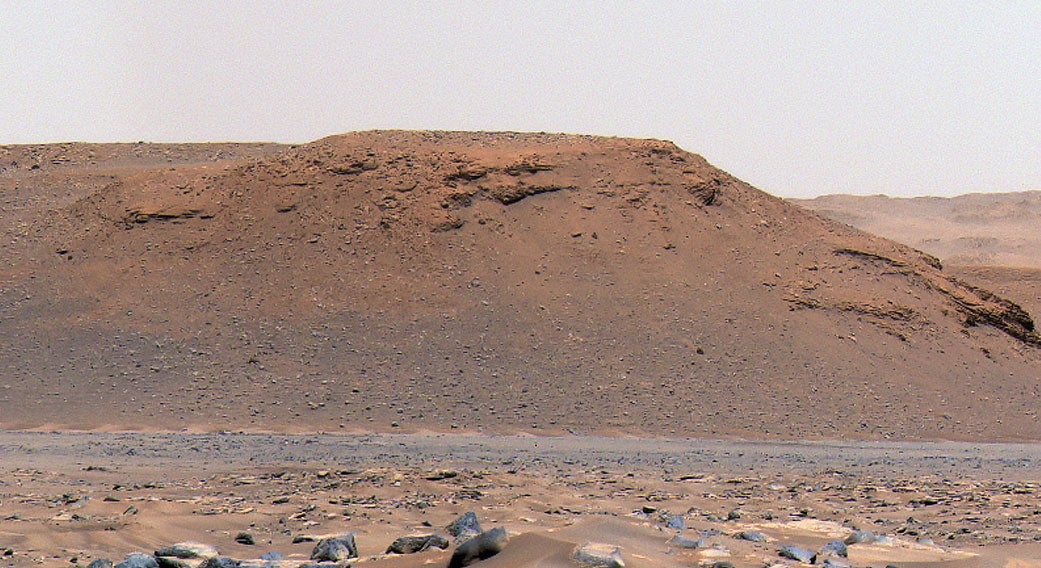Mars crater breakthrough is Nasa’s ‘best bet’ at finding alien life
The finest-grained material at lake’s bottom is ‘our best bet for finding evidence of organics and biosignatures’, said Perseverance scientist Sanjeev Gupta

Your support helps us to tell the story
From reproductive rights to climate change to Big Tech, The Independent is on the ground when the story is developing. Whether it's investigating the financials of Elon Musk's pro-Trump PAC or producing our latest documentary, 'The A Word', which shines a light on the American women fighting for reproductive rights, we know how important it is to parse out the facts from the messaging.
At such a critical moment in US history, we need reporters on the ground. Your donation allows us to keep sending journalists to speak to both sides of the story.
The Independent is trusted by Americans across the entire political spectrum. And unlike many other quality news outlets, we choose not to lock Americans out of our reporting and analysis with paywalls. We believe quality journalism should be available to everyone, paid for by those who can afford it.
Your support makes all the difference.Mars’ Jezero crater was once a lake connected to a small river that could hold traces of alien life, Nasa’s Perseverance rover has confirmed.
Billions of years ago the barren Red Planet once had an atmosphere thick enough to support flowing water.
The 100-metre-deep lake that used to be in the crater is thought to have been high enough to crest the eastern rim of the depress, where the remains of a river channel are still visible. The size of the lake changed rapidly over time, which could have been due to flooding or slower environmental changes.
“Never before has such well-preserved stratigraphy been visible on Mars,” said Nicolas Mangold, a Perseverance scientist from the Laboratoire de Planétologie et Géodynamique in Nantes, France.
“This is the key observation that enables us to once and for all confirm the presence of a lake and river delta at Jezero. Getting a better understanding of the hydrology months in advance of our arrival at the delta is going to pay big dividends down the road.”
Sanjeev Gupta, a Perseverance scientist from Imperial College London, added that a better understanding of this delta is “key to understanding the change in hydrology for the area” and could “potentially provide valuable insights into why the entire planet dried out.”
The images were taken by the rover’s dual left and right Mastcam-Z cameras as well as its Remote Micro-Imager (RMI) which help research teams decide where the vehicle should best hunt for rock and sediment samples.
The scientists hope that these samples, which could be brought back to earth by later missions, may contain organic compounds and other evidence of alien life.
The most likely source of such samples is at the bottom of that delta, but it is not the only important area for scientists to investigate. The scarps, the steep banks to the northwest of the rover approximately 2.2 kilometres away, will hold older rocks that are vital for studying Martian history.

“We saw distinct layers in the scarps containing boulders up to 5 feet [1.5 metres] across that we knew had no business being there,” said Mangold. The implication is that the slow waterway that fed into the lake must have been transformed by flash floods, travelling at a speed of up to 20 miles per hour and transporting boulders tens of miles down the river.
“These results also have an impact on the strategy for the selection of rocks for sampling,” said Sanjeev Gupta, a Perseverance scientist from Imperial College London.
“The finest-grained material at the bottom of the delta probably contains our best bet for finding evidence of organics and biosignatures. And the boulders at the top will enable us to sample old pieces of crustal rocks. Both are main objectives for sampling and caching rocks before Mars Sample Return.”
The paper on Perseverance’s scarp imagery was released online today in the journal Science.
Join our commenting forum
Join thought-provoking conversations, follow other Independent readers and see their replies
0Comments